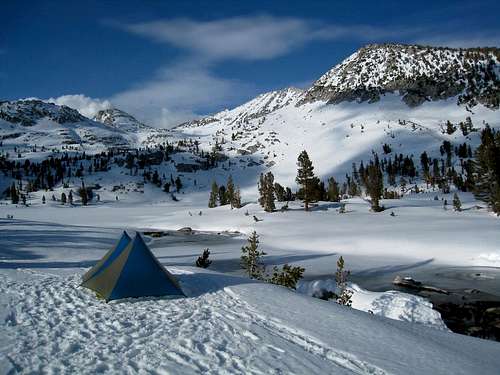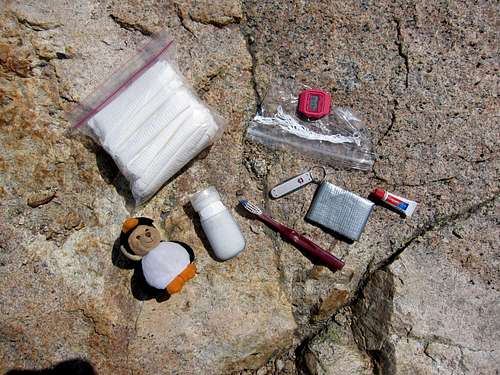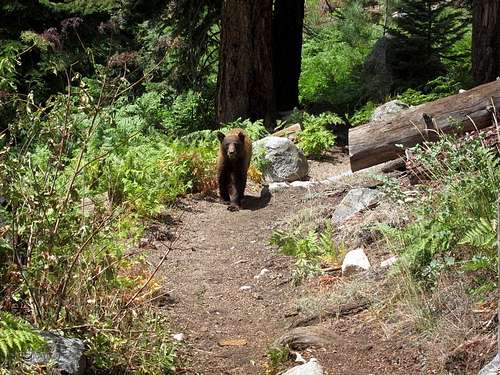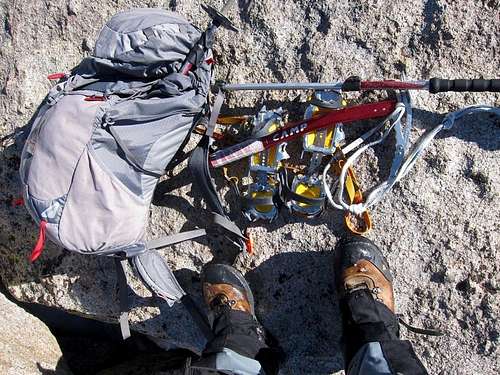mrchad9 - Oct 1, 2013 1:15 pm - Hasn't voted
Re: ExhaustiveAh good! I hope it is useful!
I keep thinking of little tidbits I need to add... things I take for granted... like not taking a bunch of keys with you (just the car key)... maybe some food details... little things.
Get your own pack weight down and its a lot easier to carry all the kid's gear too!
Bubba Suess - Oct 1, 2013 11:38 pm - Voted 10/10
Re: ExhaustiveThe kids gear...yeah, that stinks. We did an easy overnighter this year at Cliff Lake. It was a bit of a challenge with the baby, but it was fun. I cheated on this one though because we pushed the 'bob' stroller in with Laramie in it but we loaded it down with gear too. Carson is one thing but a baby is a different matter all together.
I noticed you did not mention your camera in your list of gear. Have you weighed it?
mrchad9 - Oct 2, 2013 4:07 pm - Hasn't voted
Re: ExhaustiveCamera doesn't count!
I think mine weighs about 5 ounces. I don't really count the camera though because one thing I do after each trip is photograph the pack weight, so can't really include the camera when I am doing that. Also if I have gotten it light enough I usually do not use the hip belt on the hike out, once the food is gone. When that is the case I move the camera pouch from the shoulder strap to my belt anyway just for comfort, so it is no longer in the pack anyway.
But I do stick to point and shoot cameras just for the weight savings. All the camera gear is probably nice sometimes, but not worth the cost or the effort to me. Too many pics already!
2 Bees - Oct 7, 2013 10:01 pm - Voted 10/10
WeightYou are spot on 100% on weighting everything and after every trip, if you did not use it, loose it. I use my GOPRO camera/video. My Deuter pack is lighter, but my Wide Country does not hurt my back after 5 days from carrying my touring ski's = 12 lbs.( pack's=1 lbs. diff. ). Only in winter times, I had problems with my gatorade bottle. My water filter is a small steam 100 yards long moving slow through rocks. 38 years on the trails/mts. and not sick once. I carry no phone, but in the winter, on snow, in a new area, I will carry a GPS. 2 lbs. of food a day; you eat well; I'am half that. You have me beat hands down on total weight, my pack weight runs at 19 lbs. for 5 days with food only. Off to weight things and see what can be replaced or left behind. Good Post mrchad9.
*My oops! Never say never. I will heat the water to 160F for 5 minutes if up above the creek or lake has been used - trail, humans or animals or I'll use my Sawyer filter and the liquid two part Aquamira drops if it's real bad and I need water.
mrchad9 - Oct 8, 2013 12:43 pm - Hasn't voted
Re: Weight19 pounds for a 5 day trip is not bad at all! I think I might come in at about 17... counting all the food. 9 pounds of pack plus 8 of food. Maybe another pound if I need a larger pack to contain all the food though. But if you are eating a pound per day then that's great, maybe some more gear that can be optimized. Also I think of it more as food per night, rather than per day (double the food for a 2 night 3 day as a 1 night 2 day trip).
Since doing all this it has helped me greatly. As you note extra gear is sometimes needed, but if you know exactly what it weighs and what your tradeoff is (4 oz for GPS or 5 for an extra layer for example, or if considering a more comfortable pack) then it helps make those decisions too.
Thank you so much for your comment. I appreciate it and hope the article provides some benefits or ideas!
Chad
cyffredinol - Oct 8, 2013 9:20 pm - Hasn't voted
back to the filter debate...You're definitely correct that washing or sanitizing your hands after pooping and before eating is a good idea. But I gotta agree with nartreb that this won't protect you from bacteria or protozoa in unfiltered water. If a filter is too heavy, chlorine dioxide tablets weigh hardly anything and will purify water. Though they don't taste great, I'd rather put up with that than risk getting Giardia.
Great article, though!
mrchad9 - Oct 9, 2013 1:23 pm - Hasn't voted
Re: back to the filter debate...Thanks so much for your comment and suggestion cyffredinol!
Of course you are correct... it is just that in the areas I am in I generally do not believe there is any risk of pathogens in the drinking water. But certainly this doesn't apply to everyone in all areas. Tablets are a great idea and a lightweight alternative to filters if there is a concern. I made an addition to the article based on your suggestion. Thanks for your feedback!
kevinsa - Oct 9, 2013 1:52 am - Voted 10/10
Beat me to it!Great article - I actually had plans to post something very similar. A few of my humble opinions to stir up some more conversation: 1. 12 point crampons are almost never necessary (unless ice climbing). I did Rainier last year in my six points with no issues. 2. 24oz seems a little on the heavy side for an ultralight pack - my Golite comes in at about 19oz, and I know there's lighter ones out there. 3. The most important place to slash weight is on your feet. Various studies have shown a pound on the feet to be the equivalent of 4.7-6.4 lbs. on the back. I made the switch to trail runners for backpacking and mountain approaches years ago, and it effectively doubled my range. Well, I'll keep the rest of my stupid opinions to myself - thanks for an outstanding article.
mrchad9 - Oct 9, 2013 1:36 pm - Hasn't voted
Re: Beat me to it!Great suggestions kevinsa! Please don’t hesitate to write something similar on your own… I would love to read the complete thoughts of you or anyone else. By combining ideas from multiple sources folks can identify what works for them and find more and more opportunities to optimize their total pack weight. The more opinions the better. I was surprised to find there was nothing like this on SP after all these years, would be good if there were more.
What brand and model of crampons do you use and what do they weigh? I’d be interested in checking them out. If you used them on Rainier I assume they are steel and not aluminum?
Certainly my pack is not the lightest around. I noted in the article even that I am looking for something new. But I think it is all about tradeoffs and knowing exactly what you are spending (in terms of weight) on each item. For me so far I just haven’t found a pack I like that shaves off the right number of ounces for the right change in comfort. I’m sure it is out there, and the best pack option for weight vs comfort is likely different for most every individual.
I’ve heard similar things on footwear. Perhaps I need to look into that more, but the type of outings I do are usually pretty hard on the feet. Not always on the trail, lots of talus and scree. The ankle support, extra height to keep debris out, and bit of extra padding on the ankles and sides for where I go is helpful. Maybe I should try to do something different on some trips though.
Hope to see something you might write sometime... really!
kevinsa - Oct 10, 2013 6:14 pm - Voted 10/10
Re: Beat me to it!The crampons I have been using are Hillsound Cypress 6. They are steel, and weigh 1.12 lbs. Not super light compared to aluminum, but they allow me to use lighter boots that do not have full shanks. They are also incredibly easy to put on and take off.
I decided to do a quick comparison of two of my past Rainier trips. In 1994, we did the Disappointment Cleaver route (considered the easiest), and I wore the following on my feet: Plastic boots - 5.80 lbs., OR gaiters - 0.68 lbs., 12 point crampons - 2.06 lbs. Total weight on the feet minus socks - 8.54 lbs. In 2012, we did the Emmons-Winthrop route (a bit longer than the DC route), and I wore the following on my feet: Normal hiking boots - 3.20 lbs, light weight gaiters - 0.20 lbs, and 6 point crampons - 1.12 lbs. Total weight on the feet minus socks - 4.52 lbs. Using conventional wisdom, that should equate to the equivalent of a 20 lb. pack reduction. How did it work in practice?
In 1994 (21 years old at the time), we spent three days on the DC route. When we got done, I was completely spent. In 2012, we did the Emmons/Winthrop route in 23 hours (including the overnight), and when we were done, I felt great (age 39, BTW). Granted, my gear was a little better, and my pack a little lighter, but I'll still let those results speak for themselves!
mrchad9 - Oct 14, 2013 1:30 pm - Hasn't voted
Re: Beat me to it!Thanks for the info on the crampons. I had been considering some steel strap-ons so I have more flexibility in boots... currently I have the aluminum ones (which I love for the right situations) or steel step ins. Your suggestion might be a better in between than what I was considering.
Yeah boots make a huge difference. I haven't been able to go down to trail runners, but I ditched my plastic boots a good while ago. I hate those things!
mrchad9 - Oct 9, 2013 1:43 pm - Hasn't voted
Re: Go lite, but not too lite....My gear has worked well over many seasons in the High Sierra, I think folks overdo it on layers sometimes… I do as well. I made an addition for some suggestions on filter alternatives (using iodine or chlorine dioxide tablets which weigh much less). But I haven’t used anything for nearly every outing for many years without issue.
I use a 32 degree bag down to about 20 degrees at night and have found that if I am in the right number of layers it isn’t an issue. I have heavier bags for more serious winter outings though.
I don’t plan on soaking layers while I am on the move though… if I am sweating then some layers need to come off… wear one noninsulating layer at most in those situations. As long as I have a shelter or bivy and the 32 deg bag with me I’ve been able to ride out any storms or cold weather. I was hit by a surprise snowstorm a couple of weeks ago. I had an extra insulating layer but had ditched my shell. Wasn’t always comfortable but was plenty safe and able to ride it out with the bag and other gear I had. Thanks for the comment!
ywardhorner - Oct 9, 2013 3:55 pm - Hasn't voted
Good article!I thought I was pretty good at going light, but I have to admit I never thought about Nalgene bottles! I always carry an old one in the winter to use as a pee bottle cuz there's no way I'm getting out of the tent in the middle of the night. Now that you mention it, an old Gatorade bottle would make much more sense. Thanks for the idea!
As far as soaking layers goes -- I always soak the back of my top (the part that's under my pack), even in cool weather, but I don't carry a spare. I stick to fabrics that I know will dry in 15-20 mins.
mrchad9 - Oct 10, 2013 12:20 pm - Hasn't voted
Re: Good article!I agree.... cotton kills!
I am glad the bottle suggestion might help out. Yeah I feel much better about tossing a Gatorade pee bottle in the trash than I do carrying it home with me!
mountainsandsound - Oct 9, 2013 8:09 pm - Hasn't voted
good ideasSome good ideas in this article. I have enjoyed pushing myself to go lighter and lighter over the past couple years and it actually feels pretty thrilling at times.
Unfortunately, for many trips the weight that I save by omitting gear is made up for in beer. So my pack isn't really that much lighter in the end.
mrchad9 - Oct 10, 2013 12:21 pm - Hasn't voted
Re: good ideasGlad you liked the article. Well maybe if you can shave off an extra few ounces then an additional beer can be added? So there is still a payoff.
mountainsandsound - Oct 10, 2013 6:24 pm - Hasn't voted
Re: good ideasYes, my pack still comes out lighter in the end. But not as light as it could be, because I am too tempted to throw some cans of Rainier in the empty space at the top of my pack. Maybe a smaller pack would fix that problem.
I had no idea that a Nalgene was that heavy.
goldenhopper - Oct 10, 2013 2:27 am - Hasn't voted
Jardine influence?Haha! Good stuff Chad. You covered just about everything. I read beyond Backpacking in 2001 and started to go light in 2002. I've found a comfort zone at my 14 pound base pack weight. My pack is very similar to yours, but I do like to eat hot meals no matter the length of the trip via an Esbit stove and 2L titanium pot. In the end I've found that less is more. Aside from not hauling the extra weight, I find it a better wilderness experience to make things as simple as possible; using the lanscape and my head as much as possible. My new pet peeve is someone with their Apple headphones surgically attached to their ears as they meander through the wilderness. FFS!
mrchad9 - Oct 10, 2013 12:26 pm - Hasn't voted
Re: Jardine influence?Thanks goldenhopper. Yeah I also dislike the use of electronics in the wilderness. Some can't get away from it though.
Hot food is nice too... as long as you know the tradeoff and I think weighing everything helps and then you can decide is the stover or extra layer or whatever worth X many more ounces. Sounds like you have that covered... 14 pounds is much lighter than the average person out there.
I also agree that by not taking so much gear out there it is more of a wilderness experience. I don't want to feel like I'm in a campground when I am backbacking. The less I can get by with the more I feel like I belong out there.
mountainsandsound - Oct 10, 2013 6:38 pm - Hasn't voted
for mountaineering?This seems geared toward backpacking. I'd be curious about how you apply this philosophy to Shasta trips. I have been leaving the tent behind more often during quick, fair weather trips, and on my most recent Shasta trip my brother and I went with a go-lite tarp tent, which we ultimately did not set up. It was a fun, exposed (to the elements, not to falls) bivy near the toe of the Hotlum.
















Comments
Post a Comment